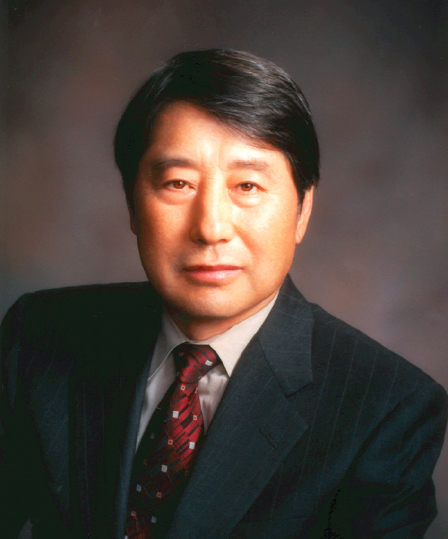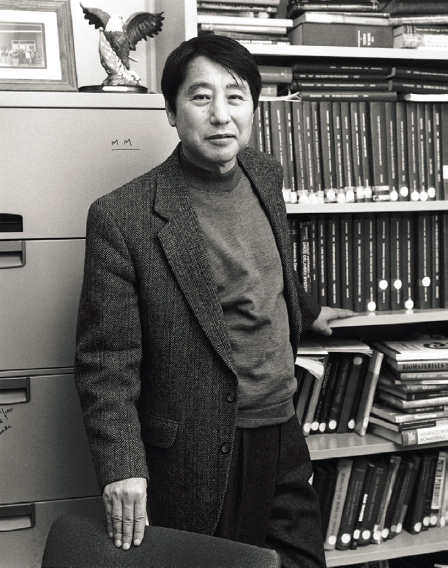

SUNG WAN KIM
1940–2020
Elected in 2003
“For the design of blood-compatible polymers with human application, including drug delivery systems.”
BY JINDŘICH KOPEČEK
SUNG WAN KIM, Distinguished Professor of Pharmaceutics and Pharmaceutical Chemistry and Distinguished Professor of Biomedical Engineering at the University of Utah, passed away at the age of 79 on February 24, 2020, in Salt Lake City.
He was born August 21, 1940, in Busan, Korea, to Jong Kyu Kim and Shin Hee Lee. After difficult times during the Korean War, he enrolled at Seoul National University, where he received his BS in chemistry in 1963 and MS in physical chemistry in 1965. While he was a master’s student, he had a chance encounter with Prof. Henry Eyring, who was visiting from the University of Utah chemistry department. Eyring suggested that Sung Wan move to the United States, and in 1966 he did, joining Eyring’s laboratory. After receiving his PhD in physical chemistry (1969) he stayed, continuing as a postdoctoral fellow with Prof. Willem Kolff, the father of artificial organs.
After doing postdoctoral research on biomaterials at the University of Utah’s Institute for Biomedical Engineering and Department of Materials Science, Sung Wan was hired in 1971 as an assistant research professor in the College of Pharmacy. This is where he started his own research in biomaterials and drug delivery systems, focusing on early events in bloodbiomaterial interactions.
His studies of the mechanism of surface-induced thrombosis guided the design of heparin-containing biomaterials, prostaglandin-releasing biomaterials, and block copolymer–based biomaterials. Other important achievements were self-regulating drug delivery systems, including insulin delivery using competitive binding of glycosylated insulin and glucose to concanavalin A. In addition, his group developed smart hydrogels and stimuli-sensitive polymers for drug delivery. In particular, the design of ReGel, a thermosensitive (when the sol-gel transition occurs after administration), biodegradable, drug-releasing injectable hydrogel, has shown great potential for the development of novel anticancer therapies.
Beginning in 1996, Sung Wan’s efforts centered on polymeric and biomolecular approaches to gene delivery. Instead of frequently used viral systems, he developed nonimmunogenic polymer-based gene carriers. The development of bioreducible polymers as gene carriers was especially significant, resulting in delivery systems with improved biological activities and biocompatibility. The advanced design was validated by the successful development of therapeutics for the treatment of cardiovascular diseases, diabetes, and cancer.
Sung Wan’s pioneering research in biomaterials and drug delivery was truly inspiring. The interdisciplinary research results from his laboratory not only were translated to clinics but also created influential scientific foundations that facilitated further inventions worldwide.
He published over 500 papers in high-impact journals and received numerous patents. Most important, he trained over 150 scientists from all over the world, creating an environment where young people could develop their talents to the fullest.
Sung Wan’s efforts enhanced the standing of the College of Pharmacy and the University of Utah around the world. In 1983 he started a biennial symposium on drug delivery, in 1986 he founded the university’s Center for Controlled Chemical Delivery (which he led as codirecor until his retirement in 2007), and over the years he initiated numerous international scientific collaborations. One noteworthy partnership was “The Triangle,” a collaboration of the University of Utah
(Kim) in the United States, University of Twente (Jan Feijen) in the Netherlands, and Tokyo Women’s Medical College (Teruo Okano) and University of Tokyo (Kazunori Kataoka) in Japan. These activities created an opportunity for students to meet and talk with leaders in the field and, through an associated exchange program, to work in different laboratories and experience diverse cultures.
Sung Wan was also a successful entrepreneur, as founder of Expression Genetics and Macromed, and cofounder of TheraTech.
For his outstanding contributions Sung Wan received numerous honors: the Biomaterials Society’s Clemson Award for Basic Research (1988), Utah Governor’s Medal for Science and Technology (1988), Controlled Release Society Founders Award (1995), Dale Wurster Award from the American Association of Pharmaceutical Scientists (1998), Volwiler Research Achievement Award from the American Association of Colleges of Pharmacy (2002), University of Utah Distinguished Research Award (1987) and Rosenblatt Prize for Excellence (2003), Korea’s Ho-Am Prize (2003), Research Achievement Award from the Pharmaceutical Sciences World Congress (2004), and Terumo Global Science Prize (2014), among others. He was a member of the National Academies of Medicine (1999) and Engineering (2003), and fellow of the National Academy of Inventors (2012). In addition, he received an honorary doctorate from the University of Twente (2006) and was designated a Distinguished Professor at Hanyang University in Korea.
He was active in service to the scientific community, including 12 years on NIH study sections. He was also a generous philanthropist who supported academic institutions, scientific conferences, and young researchers.
Sung Wan Kim was an outstanding researcher, innovator, and teacher but also a wise, modest man who enjoyed life, travel, skiing, and playing golf. He cherished personal contacts with friends and was a devoted family man. He is survived by his wife, Hee Kyung, son Alex (Catherine), daughter Kara (Brian), and four grandchildren.
Sung Wan Kim’s devotion to research and discovery, his innovative spirit, and his wisdom and kindness influenced both the careers and the character of his students, coworkers, and friends. He was a great teacher, a great scientist, and a great man.






